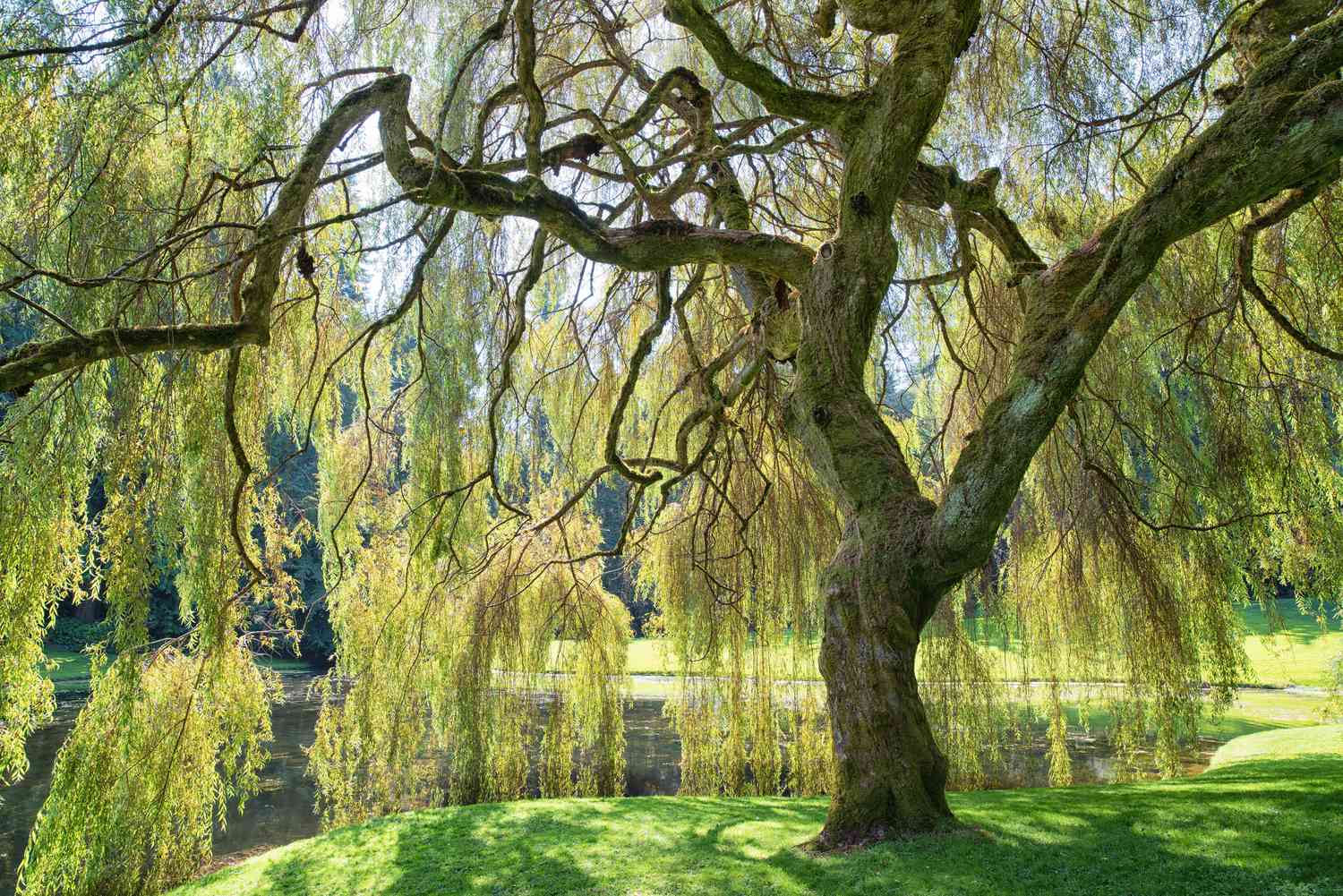
Willow trees, known for their graceful appearance and serene presence, have captivated human imagination for centuries. These elegant trees belong to the genus Salix and are widely distributed across the Northern Hemisphere, thriving in diverse environments ranging from wetlands to mountainsides. With their slender branches swaying in the breeze and delicate leaves shimmering in the sunlight, willows exude a sense of tranquility and beauty.
In this article, we'll delve into 18 fascinating facts about willow trees, exploring their cultural significance, ecological importance, and unique characteristics. From their historical symbolism to their medicinal properties, willows have woven themselves into the fabric of human history and continue to play a vital role in our natural world. So, let's embark on a journey to uncover the enchanting secrets of these enchanting trees and gain a deeper appreciation for their timeless allure.
Key Takeaways:
- Willow Trees have a rich history, from inspiring art and literature to providing medicinal benefits. Their graceful form and ecological importance make them a cherished presence in landscapes.
- Willow Trees symbolize resilience and flexibility, supporting diverse wildlife and playing a vital role in environmental conservation. Their timeless allure continues to captivate people worldwide.
Willow Trees are known for their graceful appearance and slender leaves.
These trees are often found near water bodies, with their long, sweeping branches swaying gently in the breeze. Willow trees have a rich history and a variety of uses, making them a fascinating subject to explore. Let's delve into 18 interesting facts about Willow Trees.
Willow Trees have been depicted in art and literature for centuries.
From classic paintings to contemporary poetry, Willow Trees have captured the imagination of artists and writers across the ages. Their elegant form and tranquil presence have made them a popular subject for creative expression.
Willow Trees are associated with symbolism and cultural significance in many societies.
In various cultures, Willow Trees symbolize resilience, flexibility, and the ability to bend without breaking. They are often linked to themes of healing, growth, and renewal, making them a powerful symbol in folklore and mythology.
Willow Trees have a long history of medicinal use.
The bark of Willow Trees contains a compound called salicin, which has been used for centuries to alleviate pain and reduce fever. This natural remedy served as the basis for the creation of aspirin, a widely used medication today.
Willow Trees have strong roots that seek out water.
Their extensive root systems help prevent soil erosion and provide stability to riverbanks and shorelines. This characteristic makes Willow Trees valuable in environmental conservation and landscaping.
Willow Trees are often planted for their ornamental value.
Their graceful form and weeping branches make them a popular choice in landscaping and garden design. Willow Trees add a touch of elegance and tranquility to any outdoor space.
Willow Trees are known for their rapid growth.
Under optimal conditions, Willow Trees can grow at an impressive rate, making them a valuable resource for timber and biomass production. Their fast growth also contributes to their role in phytoremediation, the process of using plants to clean up contaminated soil.
Willow Trees have a close relationship with water.
They thrive in moist environments and are commonly found along riverbanks, lakeshores, and wetlands. Their affinity for water makes them an important component of riparian ecosystems.
Willow Trees are home to diverse wildlife.
Their branches provide nesting sites for birds, while their leaves and twigs are a food source for various insects and caterpillars. Willow Trees support a rich biodiversity, playing a vital role in the ecosystem.
Willow Trees have cultural significance in East Asian traditions.
In Chinese and Japanese art and literature, Willow Trees are often depicted in serene landscapes, symbolizing resilience, grace, and the passage of time. They hold a special place in the hearts of many in East Asia.
Willow Trees have inspired music and poetry.
Their enchanting beauty and peaceful demeanor have been celebrated in numerous musical compositions and poetic verses. Willow Trees evoke a sense of serenity and contemplation, inspiring artistic expression across different genres.
Willow Trees have been used in traditional crafts.
The flexible branches of Willow Trees have been employed in basket weaving, creating intricate and durable baskets with natural materials. This traditional craft highlights the practical and versatile nature of Willow Trees.
Willow Trees have a connection to ancient folklore.
In European folklore, Willow Trees are often associated with magic, mysticism, and enchantment. They feature in tales of transformation and healing, adding a touch of enchantment to the natural world.
Willow Trees have a distinct appearance in different seasons.
During spring and summer, their lush foliage creates a verdant canopy, while in autumn, their leaves turn a golden hue before gracefully falling. In winter, their bare branches exude a sense of quiet strength and resilience.
Willow Trees have been celebrated in garden design.
Their serene presence and distinctive form have made them a favored choice in traditional and contemporary garden landscapes. Willow Trees bring a sense of tranquility and natural beauty to outdoor spaces.
Willow Trees have a place in historical literature and mythology.
From ancient texts to modern novels, Willow Trees have been depicted as symbols of wisdom, protection, and renewal. Their presence in literature reflects their enduring significance in human culture.
Willow Trees have been subject to scientific study.
Researchers have explored the ecological and physiological characteristics of Willow Trees, uncovering their role in ecosystem dynamics, phytoremediation, and environmental conservation. These studies contribute to a deeper understanding of the value of Willow Trees in the natural world.
Willow Trees have a timeless allure that continues to captivate people around the world.
Their graceful form, cultural significance, and ecological importance make them a cherished presence in landscapes and a source of inspiration for art, literature, and environmental stewardship.
Willow Trees stand as a testament to the enduring connection between nature and human creativity, embodying the harmony and resilience found in the natural world.
These 18 interesting facts about Willow Trees offer a glimpse into the captivating world of these iconic trees, showcasing their multifaceted significance and enduring appeal. Whether in art, medicine, folklore, or environmental conservation, Willow Trees continue to leave an indelible mark on the human experience, inviting us to appreciate their beauty and contemplate their timeless wisdom.
Conclusion
In conclusion, willow trees are not only visually stunning but also hold a wealth of fascinating characteristics. From their historical significance to their medicinal uses, willows have captured the imagination of people across cultures for centuries. Their resilience in adverse conditions and their role in supporting biodiversity make them an integral part of our natural landscape. By understanding the unique traits and cultural significance of willow trees, we can deepen our appreciation for these remarkable botanical wonders.
FAQs
Are willow trees difficult to grow?
Willow trees are known for their adaptability and can thrive in a variety of environments. They are relatively low-maintenance and can be grown from cuttings, making them accessible for many gardeners.
Can willow trees be harmful to the environment?
While willow trees offer numerous benefits, it's essential to consider their potential impact on local ecosystems. In some regions, willows can spread aggressively and outcompete native species, so it's important to plant them responsibly and manage their growth to prevent ecological disruption.
Was this page helpful?
Our commitment to delivering trustworthy and engaging content is at the heart of what we do. Each fact on our site is contributed by real users like you, bringing a wealth of diverse insights and information. To ensure the highest standards of accuracy and reliability, our dedicated editors meticulously review each submission. This process guarantees that the facts we share are not only fascinating but also credible. Trust in our commitment to quality and authenticity as you explore and learn with us.


